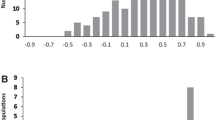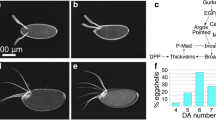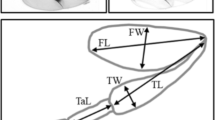Abstract
Asymmetry has been used as a measure of developmental stability for bilaterally symmetrical organisms. Most studies have failed to partition the genetic and environmental contributions to the asymmetry phenotype due to the limitations of the systems used or the shortcomings in experimental design. The Notch mutants of Drosophila melanogaster were used to study the genetic contribution to asymmetry for six different bristle characters. Asymmetry response was character specific for the mutants examined. For N spl, N Co, N 264–47, Ax 71d, Ax 9B2, Ax E2, l(1)N B and nd 2 significant asymmetry responses, relative to wildtype Canton‐S, were observed for some characters. N 60g11 and nd 1 did not exhibit significant asymmetry for any of the characters examined. All of the mutants except N 60g11 and nd 1 showed thoracic bristle asymmetry. However, when asymmetry scores were pooled over the five bristle characters which individually exhibited fluctuating asymmetry, no significant differences were found between any genotypes. Therefore pooling asymmetry values across characters obscures the significant character specific asymmetry values observed. Thus caution is necessary when using the asymmetry phenotype of specific characters to draw organism wide conclusions about developmental stability.
Similar content being viewed by others
References
Agnew, P. & J.C. Koella, 1997. Virulence, parasitic mode of transmission and host fluctuating asymmetry. Proc. R. Soc. Lond. B 264: 9–15.
Artavanis-Tsakonas, S., K. Matsuno & M.E. Fortini, 1995. Notch signalling. Science 268: 225–232.
Artavanis-Tsakonas, S., M.D. Rand & R.J. Lake, 1999. Notch signalling: cell fate control and signal integration in development. Science 284: 770–776.
Batterham, P., A.G. Davies, A.Y. Game J.A. McKenzie, 1996. Asymmetry-where evolutionary and developmental genetics meet. BioEssays 18: 841–845.
Brakefield, P.M. & C.J. Breuker, 1996. The genetic basis of fluctuating asymmetry for developmentally integrated traits in a butterfly eyespot pattern. Proc. R. Soc. Lond. B 263: 1557–1563.
Brennan, K., R. Tateson, K. Lewis & A.M. Arias, 1997. A functional analysis of Notch mutations in Drosophila. Genetics 147: 177–188.
Clarke, G.M., 1993. The genetic basis of developmental stability. I. Relationship between stability, heterozygosity and genomic coadaptation. Genetica 89: 15–23.
Clarke, G.M. & J.A. McKenzie, 1987. Developmental stability of insecticide resistant phenotypes in blowfly: a result of canalizing natural selection. Nature 325: 345–346.
Freebairn, K., J.L. Yen & J.A. McKenzie, 1996. Environmental and genetic effects on the asymmetry phenotype: diazinon resistance in the Australian sheep blowfly, Lucilia cuprina. Genetics 144: 229–239.
Dufour, K.W. & P.J. Weatherhead, 1996. Estimation of organismwide asymmetry in red-winged blackbirds and its relation to studies of mate selection. Proc. R. Soc. Lond. B 263: 769–775.
Graham, J.H., K.E. Roe & T.B. West, 1993. Effects of lead and benzene on the developmental stability of Drosophila melanogaster. Ecotoxicology 2: 185–195.
Heitzler, P. & P. Simpson, 1991. The choice of cell fate in the epidermis of Drosophila. Cell 64: 1083–1092.
Graham, J.H., J.M Emlen, D.C. Freeman, L.J Leamy & J.A. Kieser, 1998. Directional asymmetry and the measurement of developmental instability. Biol. J. Linn. Soc. 64: 1–16.
Leamy, L., 1997. Is developmental stability heritable? J.Evol.Biol. 10: 21–29.
Leary, R.F. & F.W. Allendrof, 1989. Fluctuating asymmetry as an indicator of stress: implications for conservation biology. Trends Ecol. Evol. 4: 214–217.
Leary, R.F., F.W. Allendrof & K.L. Knudsen, 1992. Genetic, environmental, and developmental causes of meristic variation in rainbow trout. Act Zool. Fennica 191: 79–95.
Lindsley, D.L. & G.G. Zimm, 1992. The Genome of Drosophila melanogaster, Academic Press, California, pp. 1066.
Lyman, D. & M.W. Young, 1993. Further evidence for function of the Drosophila Notch protein as a transmembrane receptor. Proc. Natl. Acad. Sci. USA 90: 10395–10399.
Markow, T.A., 1995. Evolutionary ecology and developmental instability. Ann. Rev. Entomol 40: 105–120.
McKenzie, J.A., 1997. Stress and asymmetry during arrested development of the Australian sheep blowfly. Proc. R. Soc. Lond. B 264: 1749–1756.
McKenzie, J.A., P. Batterham & L. Baker, 1990. Fitness and Asymmetry Modification as an Evolutionary Process. A Study in the Australian Sheep Blowfly, Lucilia cuprina and Drosophila melanogaster. Ecological and Evolutionary Genetics of Drosophila Plenum Press, New York, pp. 57–73.
McKenzie, J.A. & G.M. Clarke, 1988. Diazinon resistance, fluctuating asymmetry and fitness in the Australian sheep blowfly, Lucilia cuprina. Genetics 120: 213–220.
McKenzie, J.A. & A.Y. Game, 1987. Diazinon resistance in Lucilia cuprina: mapping of a fitness modifier. Heredity 59: 381–391.
McKenzie, J.A. & J.L. Yen, 1995. Genotype, environment and the asymmetry phenotype. Dieldrin-resistance in Lucilia cuprina (the Australian sheep blowfly). Heredity 75: 181–187.
Møller A.P., 1997. Developmental stability and fitness: a review. Am. Nat. 149: 916–932.
Møller A.P. & J.P. Swaddle, 1997. Asymmetry, Developmental Instability and Evolution. Oxford University Press, Oxford.
Mulvey, M., G. Keller & G. Meffe, 1994. Single and multiple-locus genotypes and life-history responses of Gambusia holbrooki reared at two temperatures. Evolution 48: 1810–1819.
Palmer, A.R., 1994. Fluctuating asymmetry analyses: a primer, pp. 335–364 in Developmental Instability: Its Origins and Evolutionary Implications, edited by T.A. Markow. Kluwer Academic Publishers, Dordrecht.
Palmer, A.R., 1996. Waltzing with asymmetry. Bioscience 46: 518–532.
Palmer, A.R. & C. Strobeck, 1986. Fluctuating asymmetry: measurements, analysis, patterns. Ann. Rev. Ecol. Syst. 17: 391–421.
Palmer, A.R. & C. Strobeck, 1992. Fluctuating asymmetry as a measure of developmental stability: implications of non-normal distribution and power of statistical tests. Acta Zool. Fennica 191: 57–72.
Polak, M., 1993. Parasites increase fluctuating asymmetry of male Drosophila nigrospiracula: implications for sexual selection. Genetica 89: 255–265.
Rice, W.R., 1989. Analyzing tables of statistical tests. Evolution. 43: 223–225.
Sokal, R. R. & F. J. Rohlf, 1981. Biometry. 2nd edn., W.H. Freeman, San Francisco.
Van Valen, L., 1962. A study of fluctuating asymmetry. Evolution. 16: 125–142.
Swain, D.P., 1987. A problem with the use of meristic characters to estimate developmental stability. Am.Nat. 129: 761–768.
Watson, P.J. & R. Thornhill, 1994. Fluctuating asymmetry and sexual selection. Trends Ecol. Evol. 9: 21–25.
Author information
Authors and Affiliations
Rights and permissions
About this article
Cite this article
Indrasamy, H., Woods, R., McKenzie, J. et al. Fluctuating asymmetry for specific bristle characters in Notch mutants of Drosophila melanogaster. Genetica 109, 151–159 (2000). https://doi.org/10.1023/A:1017535930657
Issue Date:
DOI: https://doi.org/10.1023/A:1017535930657




